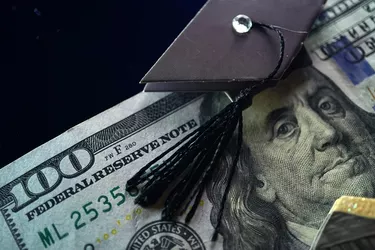
Sources of financial aid not only limit the amount a student can receive per year, but also the overall amount that a student can borrow over her lifetime. Is there a lifetime limit on financial aid? In fact, there is. The lifetime limits should allow the average student plenty of financial aid to complete education all the way up through a doctorate. However, students who complete multiple degrees at some levels might eventually run out of financial aid.
Lifetime Pell Grant Limits
Video of the Day
Students can only get Pell Grants for undergraduate studies or, in special circumstances, for completing required postbaccalaureate coursework for a teaching certification. The federal government limits Pell Grants to 18 full-time semesters, per the Department of Education. This is typically plenty of time for most students to complete their undergraduate coursework.
Video of the Day
Are you wondering, how much student aid can I get? The maximum annual Pell Grant is $5,775 per award year at the time of publication, so this is a possibility if you are a student. This amount could increase if the government increases the maximum lifetime Pell Grant limit.
Stafford Loans and Limits
Students can borrow no more than $138,500 through the federal government's Stafford loan program, explains the Institute for College Access and Success. Of this amount, the student cannot have more than $65,500 in subsidized Stafford loans. The amount you can get each year varies by your age and/or level in school. College freshmen can get $5,500, including up to $3,500, which is subsidized; $6,500 as a sophomore, including up to $4,500 that is subsidized; $7,500 as juniors and seniors (including up to $5,500 that is subsidized).
Independent undergraduates, identified as being age 24 or older and dependent students with parents that are not eligible for PLUS loans can get $9,500 when they are freshmen (including up to $3,500 that is subsidized); $10,500 as college sophomores (including up to $4,500 that is subsidized); and another $12,500 as juniors and seniors (including up to $5,500 that is subsidized). Graduate students are eligible for $20,500. Unsubsidized Stafford loans for medical students are a bit different. These are limited to $40,500 per year. According to the University of North Carolina, it is expected that a medical student would exhaust the aggregate amount of eligibility for their Stafford loan before they complete their education.
In addition to the lifetime limit, the federal government also limits the amount a student can borrow in Stafford loans for undergraduate studies. Dependent undergraduates can borrow up to $31,000, $23,000 of which can be subsidized. Independent students and students whose parents can't get PLUS loans can borrow up to $57,500 total for undergraduate studies.
Perkins Loans and Limits
When wondering, how much financial aid can you get, you should also consider Perkins loans. Some students with extreme financial need qualify for Perkins loans, which are funded by the federal government and disbursed by the school.
A student cannot get more than $60,000 total in Perkins loans in his lifetime. Of this amount, only $27,500 can come through undergraduate studies.
Other Financial Aid Options
Other types of financial aid might have their own lifetime limits, depending on who is issuing the aid. For example, a school might only offer institutional grants for students for their first four years of undergraduate study because most students who are academically motivated finish by then. State financial aid agencies might also set limits on the amount students can get in grants or loans, but these vary from one state to another.
Private lenders might be wary of issuing additional student loans to someone who already has hundreds of thousands of dollars in debt. In addition, students should be cautious about taking on too many loans, as they may be very difficult to pay back. This decision should be carefully considered and should include an honest appraisal of your career earning potential and the job market at the time you are applying for loans. It is sometimes possible to cancel financial aid or loans, so be sure to inquire if you've just signed up for something and realized it isn't a fit for you.